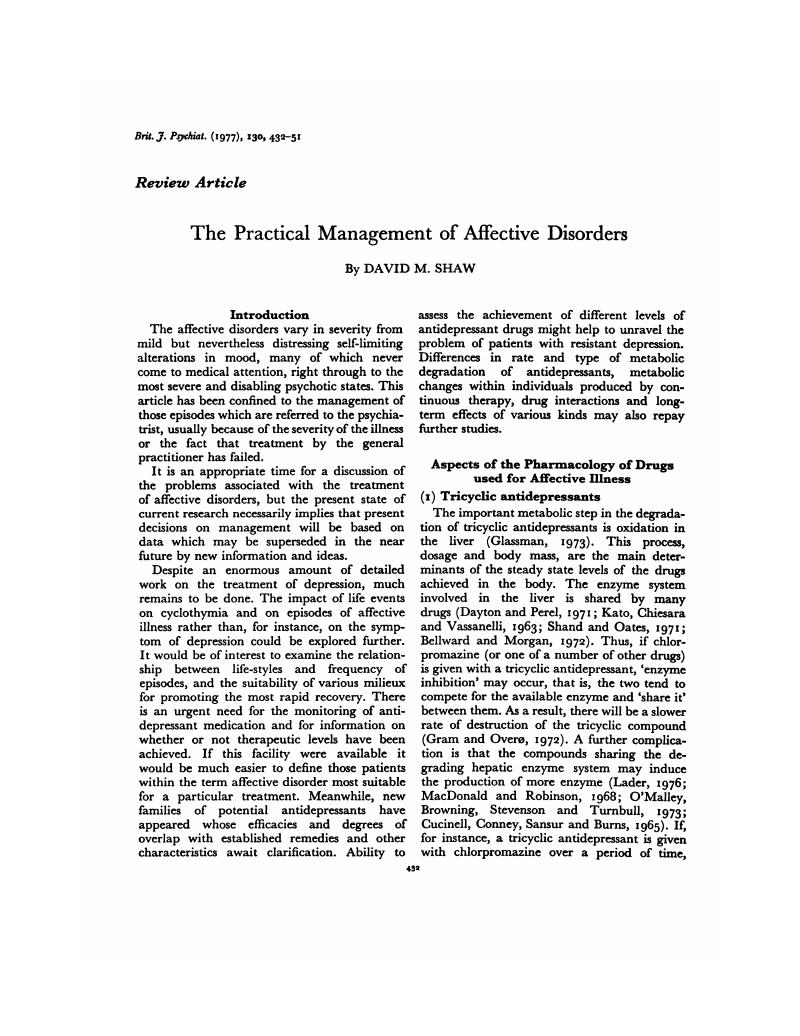Crossref Citations
This article has been cited by the following publications. This list is generated based on data provided by Crossref.
Bridges, P. K.
and
Bartlett, J. R.
1977.
Psychosurgery: Yesterday and Today.
British Journal of Psychiatry,
Vol. 131,
Issue. 3,
p.
249.
Freyhan, Fritz A.
1978.
Treatment-resistant or untreatable?.
Comprehensive Psychiatry,
Vol. 19,
Issue. 2,
p.
97.
Checkley, S. A.
1978.
A New Distinction between the Euphoric and the Anti-Depressant Effects of Methylamphetamine.
British Journal of Psychiatry,
Vol. 133,
Issue. 5,
p.
416.
Marco, Emilio J.
and
Meek, James L.
1979.
The effects of antidepressants on serotonin turnover in discrete regions of rat brain.
Naunyn-Schmiedeberg's Archives of Pharmacology,
Vol. 306,
Issue. 1,
p.
75.
Chen, Char-Nie
1979.
Sleep, Depression and Antidepressants.
British Journal of Psychiatry,
Vol. 135,
Issue. 5,
p.
385.
Tantam, Digby
1979.
Primary Mental Health Care in the United Kingdom.
International Journal of Mental Health,
Vol. 8,
Issue. 2,
p.
108.
Villeneuve, A.
1979.
Neuropsychopharmacology.
p.
187.
Liebowitz, Michael R.
and
Klein, Donald F.
1979.
Hysteroid Dysphoria.
Psychiatric Clinics of North America,
Vol. 2,
Issue. 3,
p.
555.
MACFIE, CRAIGIE
1980.
PSYCHIATRY.
Medical Journal of Australia,
Vol. 1,
Issue. 9,
p.
405.
Kennedy, Peter
1980.
The Use of Psychiatric Drugs for Decades.
British Journal of Psychiatry,
Vol. 137,
Issue. 4,
p.
387.
Tyrer, Peter
Gardner, Martin
Lambourn, John
and
Whitford, Mervyn
1980.
Clinical and Pharmacokinetic Factors Affecting Response to Phenelzine.
British Journal of Psychiatry,
Vol. 136,
Issue. 4,
p.
359.
Voineskos, George
and
Pollock, Bruce G.
1980.
Concepts and Practice of Prognosis in Psychiatry.
The Canadian Journal of Psychiatry,
Vol. 25,
Issue. 8,
p.
619.
Nielsen, I. Møller
1980.
Psychotropic Agents.
Vol. 55 / 1,
Issue. ,
p.
399.
Kline, N. S.
and
Cooper, T. B.
1980.
Psychotropic Agents.
Vol. 55 / 1,
Issue. ,
p.
369.
Shopsin, Baron
and
Waters, Brent
1980.
The pharmacotherapy of major depressive syndrome Part 1: Treatment of acute depression.
Psychosomatics,
Vol. 21,
Issue. 7,
p.
542.
Larsen, J. K.
and
Rafaelsen, O. J.
1980.
Long‐term treatment of depression with isocarboxazide.
Acta Psychiatrica Scandinavica,
Vol. 62,
Issue. 5,
p.
456.
Szabadi, E.
Gaszner, P.
and
Bradshaw, C. M.
1980.
The Peripheral Anticholinergic Activity of Tricyclic Antidepressants: Comparison of Amitriptyline and Desipramine in Human Volunteers.
British Journal of Psychiatry,
Vol. 137,
Issue. 5,
p.
433.
Riley, G. J.
and
Shaw, D. M.
1981.
Plasma tryptophan binding to albumin in unipolar depressives.
Acta Psychiatrica Scandinavica,
Vol. 63,
Issue. 2,
p.
165.
Martini, A
Bonollo, L
Nicolis, FB
Sega, R
and
Palermo, A
1981.
Effects of caroxazone, a reversible monoamine oxidase inhibitor, on the pressor response to oral tyramine in man..
British Journal of Clinical Pharmacology,
Vol. 11,
Issue. 6,
p.
611.
Rapp, Morton S.
and
Kaplan, Allan
1981.
Polypsychopharmacy Revisited.
The Canadian Journal of Psychiatry,
Vol. 26,
Issue. 8,
p.
569.






eLetters
No eLetters have been published for this article.